COSMO–SkyMed Synthetic Aperture Radar Data to Observe the Deepwater Horizon Oil Spill
Abstract
:1. Introduction
- area covered, due to its large swath mode;
- continuous and almost near real-time operability, due to the dense revisit time.
2. The Deepwater Horizon Incidental Oil Spill: A Case Study
- The spill originated from a water-depth of 1500 m. This has confounded many problems on understanding the behavior of the oil [36,37]. In general, oil at sea is influenced by a number of advective processes, e.g., wind and wave advection, spreading, emulsification, etc., and bio-geochemical processes, e.g., weathering. The latter is a process that alters the oil’s chemical and physical properties. In addition to the conventional weathering process on the surface, the DWH oil was subjected to weathering as it ascended from the well. In fact, DWH oil appeared to be incorporating water as it emerged on the surface [36,37];
- Fresh oil was continuously released. Unlike “conventional” tanker oil spills, where oil is released at once, the DWH oil spill was far more challenging due to continuous fresh oil release. Hence, in a continuous release situation, there is a mixture of fresh and weathered oil (of various degrees), as well as emulsified oil;
- A massive use of dispersants was made to mitigate the oil’s impact on the environment [33,36]. The dispersants help to reduce the oil-water interfacial tension, which when aided by the addition of energy in the form of wind/waves, can help to enhance natural dispersion of the oil. During the DWH oil spill, nearly two million gallons of chemical dispersant were used both on the surface and directly onto the gushing oil at the wellhead in an attempt to keep some of the oil under the water surface (see Figure 1b). Scientists believe that BP’s excessive use of dispersants has contributed significantly to the enormous underwater oil plumes that remain in the Gulf, one of which was 22 miles long and six miles wide [33,36];
- according to the National Oceanic and Atmospheric Agency (NOAA) estimates, the polluted area was so large (10,000 km) to suggest closing the fishery boundaries (see the area within the red line in Figure 1c) [32]. This hampered traditional approaches to provide a synoptic spill observation, thus making remote sensing a key asset [38].
3. Experiments and Discussion
3.1. Oil Spill Detection
3.2. Dual Co-Polarization Analysis
4. Conclusions
Author Contributions
Funding
Acknowledgments
Conflicts of Interest
Abbreviations
| SAR | Synthetic Aperture Radar |
| DWH | Deepwater Horizon |
| CSK | COSMO-SkyMed |
| HH | Horizontal transmit Horizontal receive |
| VV | Vertical transmit Vertical receive |
| PP | Ping Pong |
| NRCS | Normalized Radar Cross-Section |
| SCS | Single-look Complex Slant |
| BP | British Petroleum |
| NOAA | National Oceanic and Atmospheric Agency |
| GMF | Geophysical Model Function |
| OSCAT | Oceansat-2 |
| NASA | National Aeronautics and Space Administration |
| JPL | Jet Propulsion Laboratory |
| dB | Decibel |
| GLCM | Gray-Level Co-occurrence Matrix |
| ASM | Angular Second Moment |
| RGB | Red Green Blue |
| ROI | Region Of Interest |
| Probability Density Function | |
| Jeffries–Matusita | |
| ASI | Agenzia Spaziale Italiana |
References
- Costanza, R. The ecological, economic, and social importance of the oceans. Ecol. Enon. 1999, 31, 199–213. [Google Scholar] [CrossRef]
- Visbeck, M. Ocean science research is key for a sustainable future. Nat. Commun. 2018, 9, 1–4. [Google Scholar] [CrossRef] [PubMed]
- Fanning, L.; Mahon, R.; Baldwin, K.; Douglas, S. Transboundary Large Marine Ecosystems. In Transboundary Waters Assessment Programme (TWAP) Assessment of Governance Arrangements for the Ocean; Intergovernmental Oceanographic Commission Technical Series 119; United Nations Educational, Scientific and Cultural Organization: Paris, France, 2015. [Google Scholar]
- United Nations. The Sustainable Development Goals Report 2016; United Nations: New York, NY, USA, 2016. [Google Scholar]
- Fingas, M.; Brown, C.E. Review of Oil Spill Remote Sensing. Spill Sci. Technol. Bull. 1997, 4, 199–208. [Google Scholar] [CrossRef]
- Fingas, M.; Brown, C.E. Oil Spill Remote Sensing. In Handbook of Oil Spill Science and Technology; Fingas, M., Ed.; Wiley: New York, NY, USA, 2015; pp. 313–356. ISBN 978-0-470-45551-7. [Google Scholar]
- Leifer, I.; Lehr, W.J.; Simecek-Beatty, D.; Bradley, E.; Clark, R.; Dennison, P.; Hu, Y.; Matheson, S.; Jones, C.E.; Holt, B.; et al. State of the art satellite and airborne marine oil spill remote sensing: Application to the BP oil spill. Remote Sens. Environ. 2012, 124, 185–209. [Google Scholar] [CrossRef]
- Beyer, J.; Trannum, H.C.; Bakke, T.; Hodson, P.V.; Collier, T.K. Environmental effects of the Deepwater Horizon oil spill: A review. Mar. Pollut. Bull. 2016, 110, 28–51. [Google Scholar] [CrossRef] [PubMed]
- Solberg, A.H.S. Remote Sensing of Ocean Oil Spill Pollution. Proc. IEEE 2012, 10, 2931–2945. [Google Scholar] [CrossRef]
- Migliaccio, M.; Nunziata, F.; Buono, A. SAR polarimetry for sea oil slick observation. Int. J. Remote Sens. 2015, 36, 3243–3273. [Google Scholar] [CrossRef] [Green Version]
- Brekke, C.; Solberg, A.H.S. Oil spill detection by satellite remote sensing. Remote Sens. Environ. 2005, 95, 1–13. [Google Scholar] [CrossRef]
- Gade, M.; Alpers, W.; Huhnerfuss, H.; Masuko, H.; Kobayashi, T. Imaging of Biogenic and Anthropogenic Ocean Surface Films by the Multifrequency/Multipolarization SIR-C/X-SAR. J. Geophys. Res. 1998, 103, 18851–18866. [Google Scholar] [CrossRef]
- Wismann, V.; Gade, M.; Alpers, W.; Huhnerfuss, H. Radar signatures of marine mineral oil spills measured by an airborne multi-frequency radar. Int. J. Remote Sens. 1998, 19, 3607–3623. [Google Scholar] [CrossRef]
- Nunziata, F.; de Macedo, C.R.; Buono, A.; Velotto, D.; Migliaccio, M. On the analysis of a time series of X-band TerraSAR-X SAR imagery over oil seepages. Int. J. Remote Sens. 2018. in print. [Google Scholar]
- Girard-Ardhuin, F.; Mercier, G.; Collard, F.; Garello, R. Operational Oil-Slick Characterization by SAR Imagery and Synergistic Data. IEEE J. Ocean. Eng. 2005, 30, 487–495. [Google Scholar] [CrossRef]
- Pavlakis, P.; Sieber, A.J.; Alexandry, S. Monitoring oil-spill pollution in the Mediterranean with ERS SAR. Earth Obs. Q. 1994, 52, 8–11. [Google Scholar]
- Mercier, G.; Girard-Ardhuin, F. Partially Supervised Oil-Slick Detection by SAR Imagery Using Kernel Expansion. IEEE Trans. Geosci. Remote Sens. 2006, 44, 2839–2846. [Google Scholar] [CrossRef] [Green Version]
- Topouzelis, K.N. Oil Spill Detection by SAR Images: Dark Formation Detection, Feature Extraction and Classification Algorithms. Sensors 2008, 8, 6642–6659. [Google Scholar] [CrossRef] [PubMed] [Green Version]
- Dietrich, J.C.; Trahan, C.J.; Howard, M.T.; Fleming, J.G.; Weaver, R.J.; Tanaka, S.; Yu, L.; Luettich, R.A., Jr.; Dawson, C.N.; Westerink, J.J.; et al. Surface trajectories of oil transport along the Northern Coastline of the Gulf of Mexico. Cont. Shelf Res. 2012, 41, 17–47. [Google Scholar] [CrossRef]
- Cheng, Y.; Liu, B.; Li, X.; Nunziata, F.; Xue, Q.; Ding, X.; Migliaccio, M.; Pichel, W.G. Monitoring of oil spill trajectories with COSMO-SkyMed X-band SAR images and model simulation. IEEE J. Sel. Top. Appl. Earth Obs. Remote Sens. 2014, 7, 2895–2901. [Google Scholar] [CrossRef]
- Montuori, A.; Nunziata, F.; Migliaccio, M.; Sobieski, P. X-band two-scale sea surface scattering model to predict the contrast due to an oil slick. IEEE J. Sel. Top. Appl. Earth Obs. Remote Sens. 2016, 13, 4970–4978. [Google Scholar] [CrossRef]
- Migliaccio, M.; Nunziata, F.; Gambardella, A. On the Co-polarised Phase Difference for Oil Spill Observation. Int. J. Remote Sens. 2009, 30, 1587–1602. [Google Scholar] [CrossRef]
- Velotto, D.; Migliaccio, M.; Nunziata, F.; Lehner, S. Dual-polarized TerraSAR-X Data for Oil Spill Observation. IEEE Trans. Geosci. Remote Sens. 2011, 30, 1587–1602. [Google Scholar] [CrossRef]
- Jones, C.E.; Minchew, B.; Holt, B.; Hensley, S. Studies of the Deepwater Horizon Oil Spill with the UAVSAR Radar. In Monitoring and Modeling the Deepwater Horizon Oil Spill: A Record-Breaking Enterprise; Geophysical Monograph Series 195; American Geophysical Union: Washington, DC, USA, 2011; pp. 33–50. [Google Scholar]
- Minchew, B.; Jones, C.E.; Holt, B. Polarimetric Analysis of Backscatter from Deepwater Horizon Oil Spill Using L-band Synthetic Aperture Radar. IEEE Trans. Geosci. Remote Sens. 2012, 50, 1–19. [Google Scholar] [CrossRef]
- Singha, S.; Ressel, R.; Velotto, D.; Lehner, S. A Combination of Traditional and Polarimetric Features for Oil Spill Detection Using TerraSAR-X. IEEE J. Sel. Top. Appl. Earth Obs. Remote Sens. 2016, 9, 4979–4990. [Google Scholar] [CrossRef]
- Nunziata, F.; Gambardella, A.; Migliaccio, M. On the Mueller Scattering Matrix for SAR Sea Oil Slick Observation. IEEE Geosci. Remote Sens. Lett. 2008, 5, 691–965. [Google Scholar] [CrossRef]
- Buono, A.; Nunziata, F.; de Macedo, C.R.; Velotto, D.; Migliaccio, M. A sensitivity analysis of the standard deviation of the copolarized phase difference for sea oil slick observation. IEEE Trans. Geosci. Remote Sens. 2018. in print. [Google Scholar]
- Gambardella, A.; Giacinto, G.; Migliaccio, M.; Montali, A. One-class classification for oil spill detection. Pattern Anal. Appl. 2010, 13, 349–366. [Google Scholar] [CrossRef]
- Migliaccio, M.; Nunziata, F. On the Exploitation of Polarimetric SAR Data to Map Damping Properties of the Deepwater Horizon Oil Spill. Int. J. Remote Sens. 2014, 35, 3499–3519. [Google Scholar] [CrossRef]
- Garcia-Pineda, O.; Holmes, J.; Rissing, M.; Jones, R.; Wobus, C.; Svejkovsky, J.; Hess, M. Detection of Oil near Shorelines during the Deepwater Horizon Oil Spill Using Synthetic Aperture Radar (SAR). Remote Sens. 2017, 9, 567–586. [Google Scholar] [CrossRef]
- National Oceanographic and Atmospheric Administration Office of Response and Restoration. Deepwater Horizon Oil: Characteristics and Concerns. Available online: http://docs.lib.noaa.gov/noaa_documents/DWH_IR/reports/OilCharacteristics.pdf (accessed on 10 June 2018).
- National Commission on the BP Deepwater Horizon Oil Spill and Offshore Drilling. Final Report to the President: The Gulf Oil Disaster and the Future of Offshore Drilling. Available online: http:// www.oilspillcommission.gov/final-report (accessed on 21 June 2018).
- Liu, Y.; Macfadyen, A.; Ji, Z.-G.; Weisberg, R.H. Monitoring and Modeling the Deepwater Horizon Oil Spill: A Record-Breaking Enterprise; Geophysical Monograph Series 195; American Geophysical Union: Washington, DC, USA, 2011; p. 271. [Google Scholar]
- Nunziata, F.; Migliaccio, M. International Oil Spill Response Technical Seminar: Oil Spill Monitoring and Damage Assessment via PolSAR Measurements. Aquat. Procedia 2015, 3, 95–102. Available online: www.sciencedirect.com (accessed on on 5 May 2018). [CrossRef]
- National Oceanic and Atmospheric Administration. Natural Resource Damage Assessment: Status Update for the Deepwater Horizon Oil Spill. Available online: http://www.gulfspillrestoration.noaa.gov (accessed on 12 June 2018).
- Yapa, P.D.; Wimalaratne, M.R.; Dissanayake, A.L.; DeGraff, A., Jr. How Does Oil and Gas Behave When Released in Deepwater? J. Hydro-Environ. Res. 2012, 6, 275–285. [Google Scholar] [CrossRef]
- Ivshina, I.B.; Kuyukina, M.S.; Krivoruchko, A.V.; Elkin, A.A.; Makarov, S.O.; Cunningham, C.J.; Peshkur, T.A.; Atlas, R.M.; Philp, J.C. Oil spill problems and sustainable response strategies through new technologies. Environ. Sci.-Process. Impacts 2015, 17, 1211–1209. [Google Scholar] [CrossRef] [PubMed] [Green Version]
- Vilcaez, J.; Li, L.; Hubbard, S.S. A new model for the biodegradation kinetics of oil droplets: Application to the Deepwater Horizon oil spill in the Gulf of Mexico. Geochem. Trans. 2013, 14, 1–14. [Google Scholar] [CrossRef] [PubMed]
- Valentine, D.L.; Fisher, G.B.; Bagby, S.C.; Nelson, R.K.; Reddy, C.M.; Sylva, S.P.; Woo, M.A. Fallout Plume of Submerged Oil from Deepwater Horizon. Proc. Natl. Acad. Sci. USA 2014, 111, 15906–15911. [Google Scholar] [CrossRef] [PubMed]
- Streett, D.D. NOAA’S Satellite Monitoring Of Marine Oil. In Monitoring and Modeling the Deepwater Horizon Oil Spill: A Record-Breaking Enterprise; Geophysical Monograph Series 195; American Geophysical Union: Washington, DC, USA, 2011; pp. 13–91. [Google Scholar]
- Alpers, W.; Holt, B.; Zeng, K. Oil spill detection by imaging radars: Challenges and pitfalls. Remote Sens. Environ. 2017, 201, 133–147. [Google Scholar] [CrossRef]
- Zhang, B.; Perrie, W.; Vachon, P.W.; Li, X.; Pichel, W.G.; Guo, J.; He, Y. Ocean Vector Winds Retrieval from C-Band Fully Polarimetric SAR Measurements. IEEE Trans. Geosci. Remote Sens. 2012, 50, 4252–4261. [Google Scholar] [CrossRef]
- Li, X.-M.; Lehner, S. Algorithm for Sea Surface Wind Retrieval from TerraSAR-X and TanDEM-X Data. IEEE Trans. Geosci. Remote Sens. 2014, 52, 2928–2939. [Google Scholar] [CrossRef]
- Ren, Y.; Li, X.-M.; Zhou, G. Sea Surface Wind Retrievals from SIR-C/X-SAR Data: A Revisit. Remote Sens. 2015, 7, 3548–3564. [Google Scholar] [CrossRef] [Green Version]
- Stopa, J.E.; Ardhuin, F.; Chapron, B.; Collard, F. Estimating wave orbital velocity through the azimuth cutoff from space-borne satellites. J. Geophys. Res. 2015, 120, 7616–7634. [Google Scholar] [CrossRef]
- Grieco, G.; Lin, W.; Migliaccio, M.; Nirchio, F.; Portabella, M. Dependency of the Sentinel-1 azimuth wavelength cut-off on significant wave height and wind speed. Int. J. Remote Sens. 2016, 37, 5086–5104. [Google Scholar] [CrossRef]
- NASA JPL. Physical Oceanography Distributed Active Archive Center. Available online: https://podaac.jpl.nasa.gov/dataset/OS2$_$OSCAT$_$LEVEL$_$2B$_$OWV$_$COMP$_$12$_$V2 (accessed on 12 June 2018).
- National Oceanic and Atmospheric Administration. National Data Buou Center. Available online: https://www.ndbc.noaa.gov/ (accessed on 1 July 2018).
- Ressel, R.; Frost, A.; Lehner, S. A Neural Network-Based Classification for Sea Ice Types on X-Band SAR Images. IEEE J. Sel. Top. Appl. Earth Obs. Remote Sens. 2015, 8, 3672–3680. [Google Scholar] [CrossRef]
- Singha, S.; Vespe, M.; Trieschmann, O. Automatic Synthetic Aperture Radar based oil spill detection and performance estimation via a semi-automatic operational service benchmark. Mar. Pollut. Bull. 2013, 73, 199–209. [Google Scholar] [CrossRef] [PubMed]
- Haralick, R.M.; Shanmugam, K.; Dinstein, I. Textural Features for Image Classification. IEEE Trans. Syst. Man Cybern. 1973, 6, 610–621. [Google Scholar] [CrossRef]
- Soh, L.-K.; Tsatsoulis, C. Texture Analysis of SAR Sea Ice Imagery Using Gray Level Co-Occurrence Matrices. IEEE Trans. Geosci. Remote Sens. 1999, 37, 780–795. [Google Scholar] [CrossRef]
- Valenzuela, G.R. Scattering of Electromagnetic Waves from the Ocean. In Surveillance of Environmental Pollution and Resources by Electromagnetic Waves; NATO Advanced Study Institutes Series (Series C—Mathematical and Physical Sciences); Springer: Dordrecht, The Netherlands, 1978; Volume 45, pp. 199–226. [Google Scholar]
- Swain, P.H.; Davis, S.M. Remote Sensing: The Quantitative Approach; McGraw-Hill: New York, NY, USA, 1978. [Google Scholar]
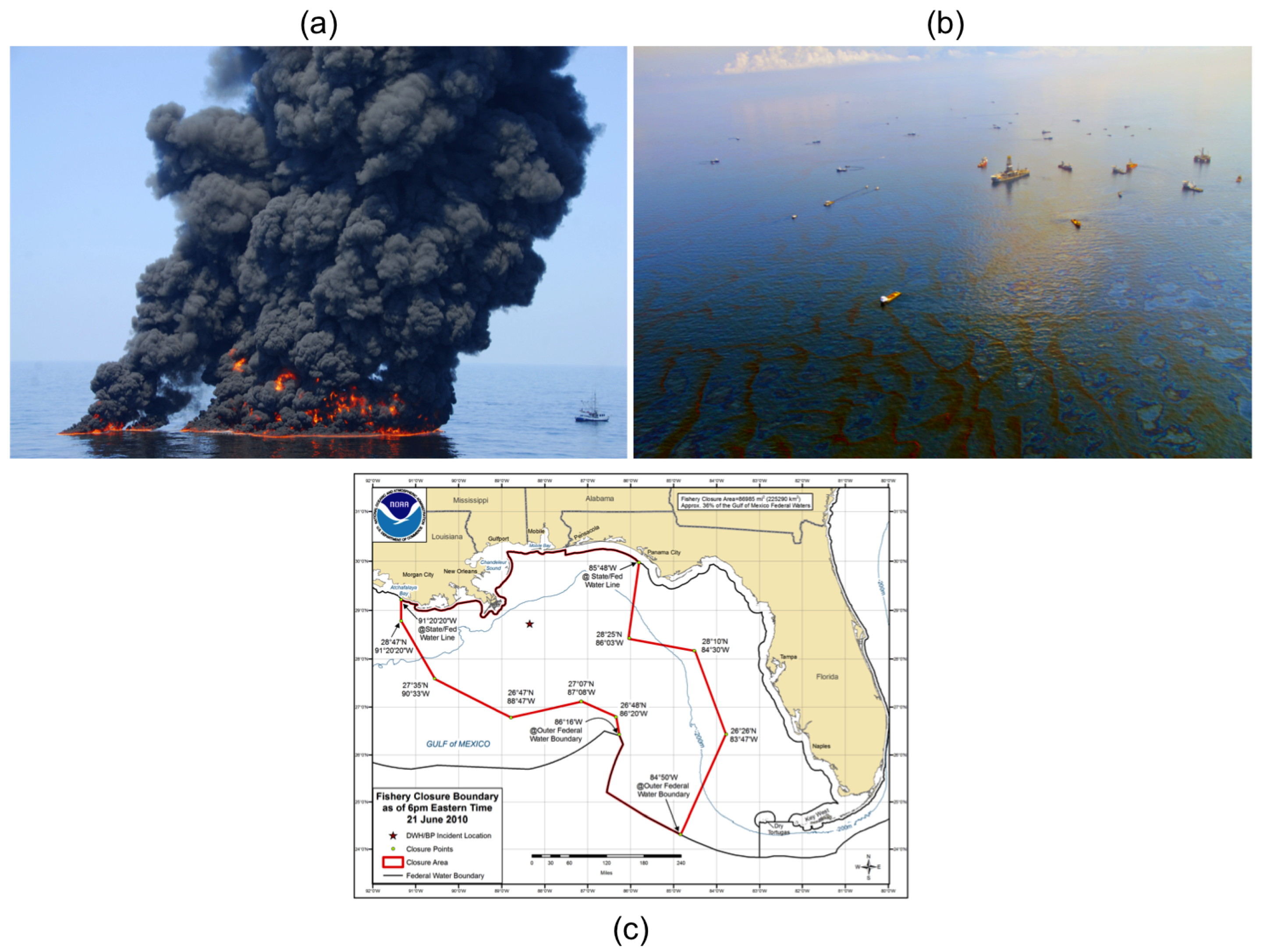
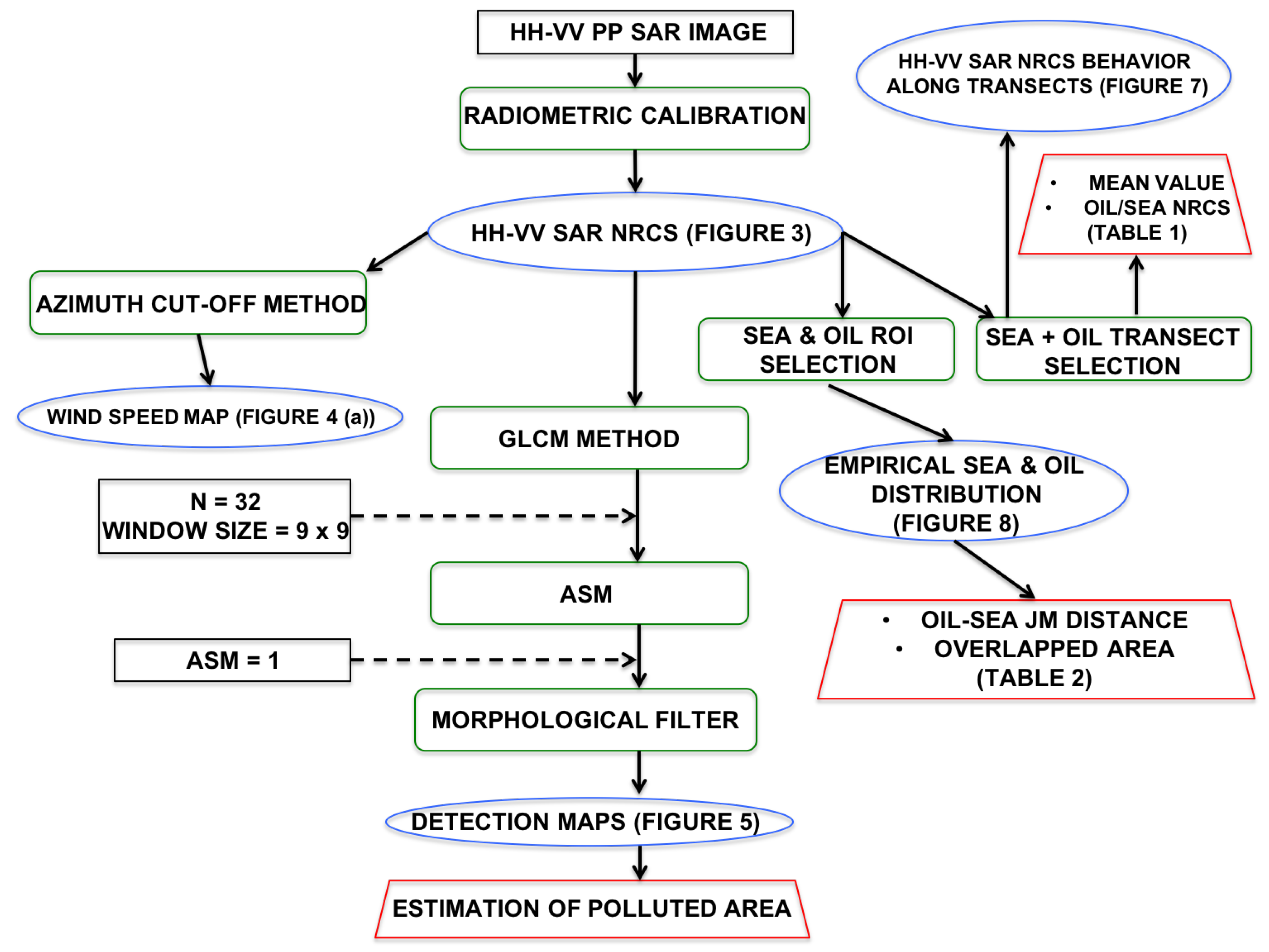
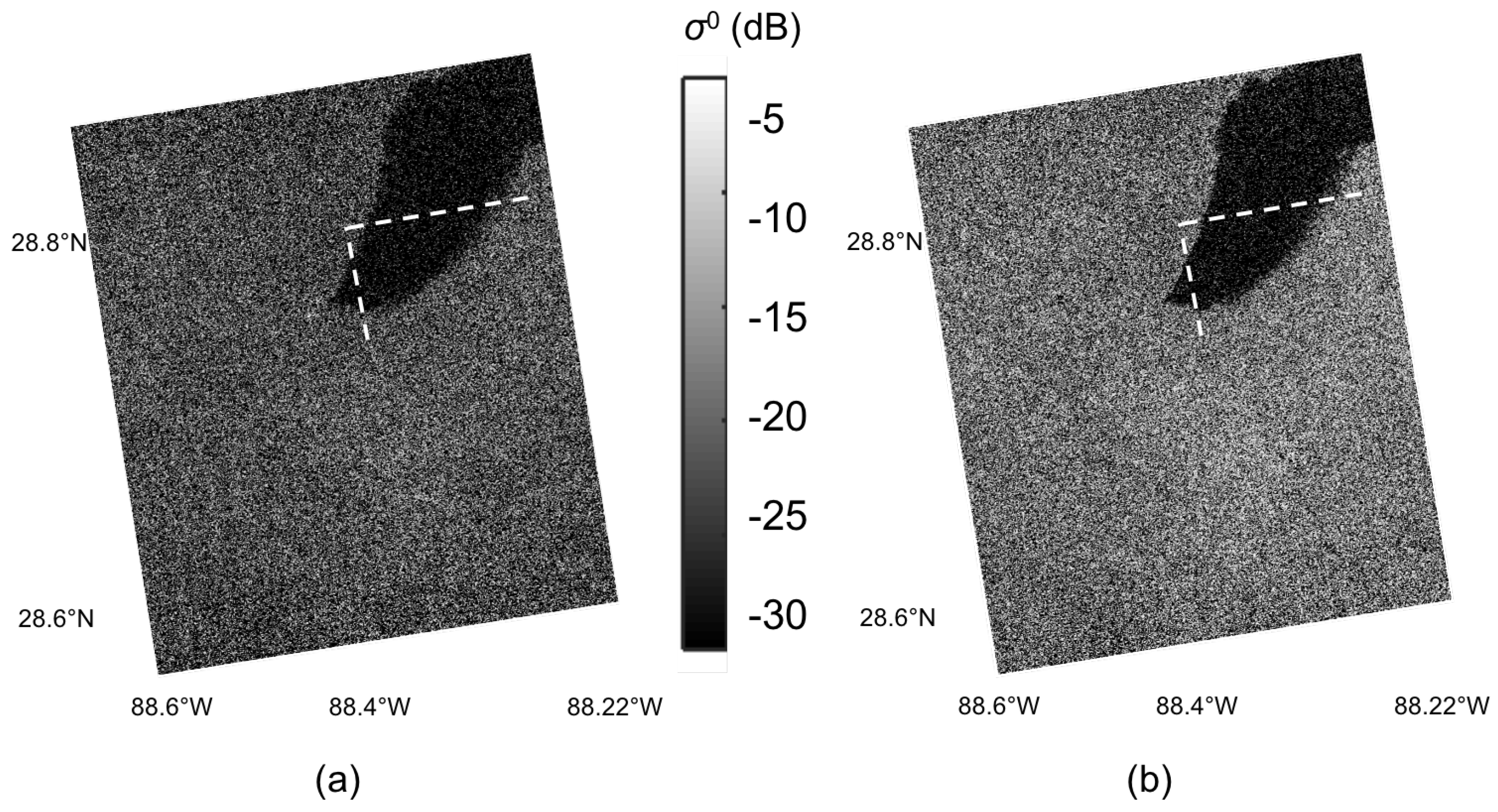
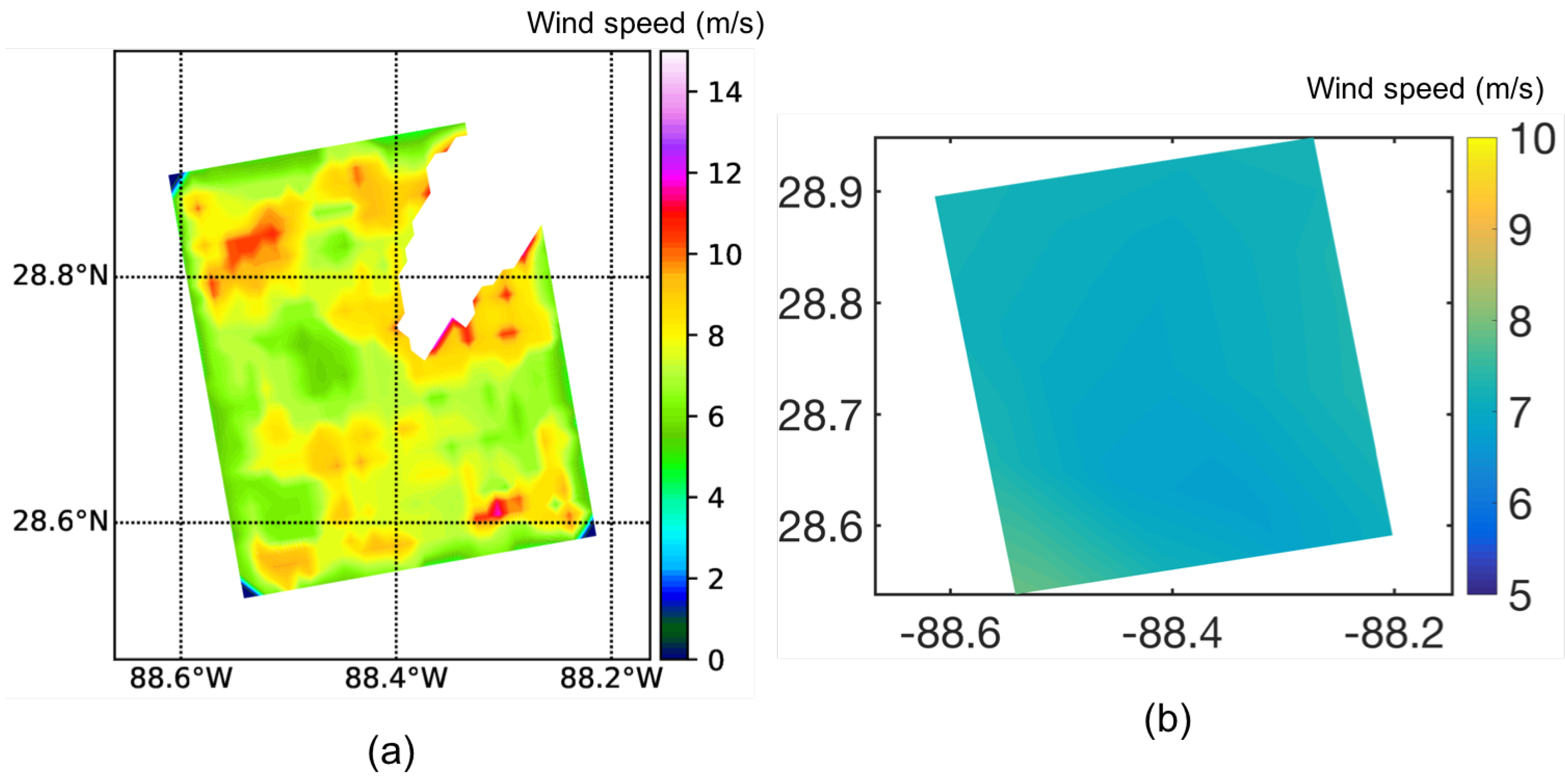
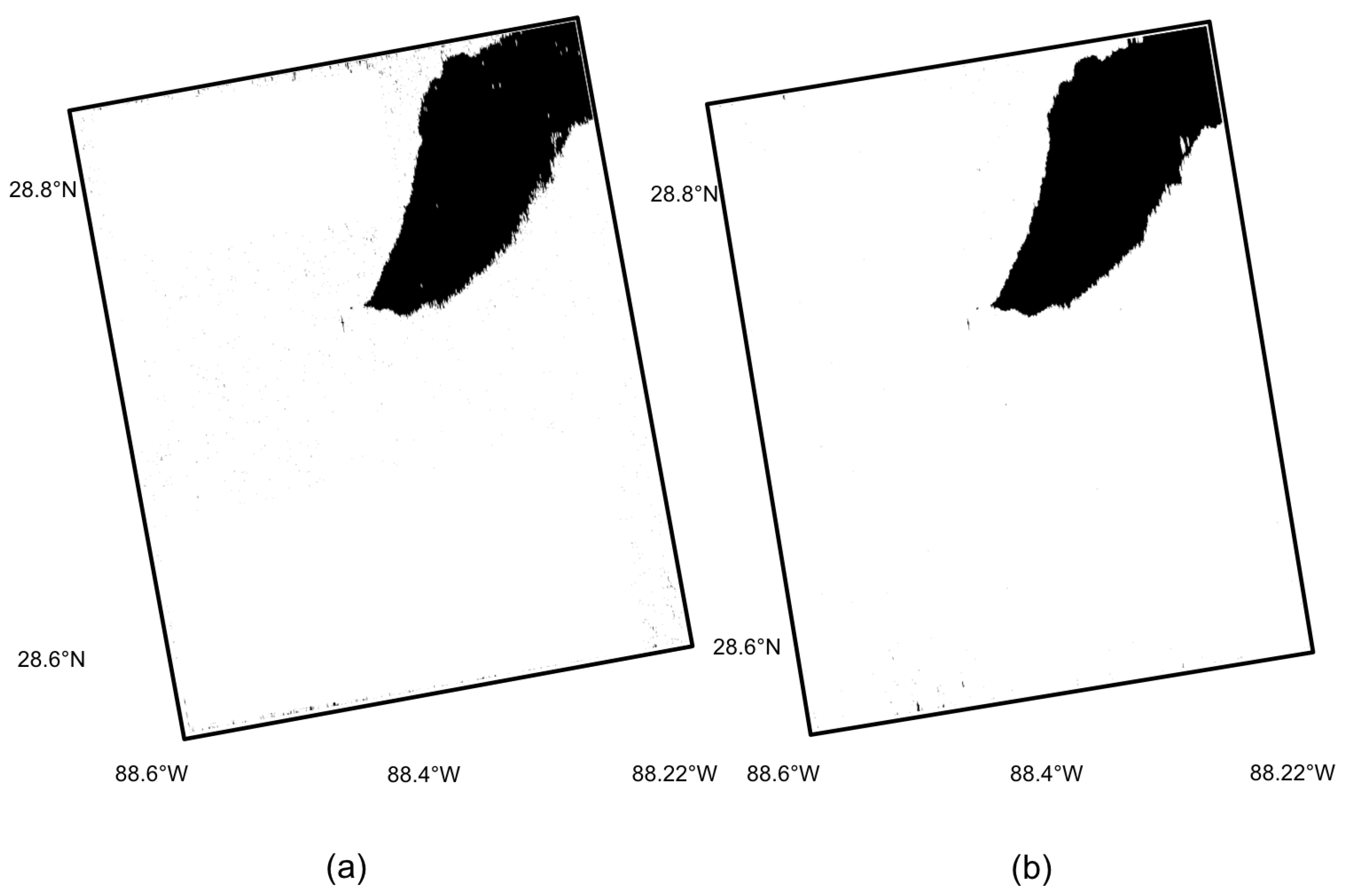
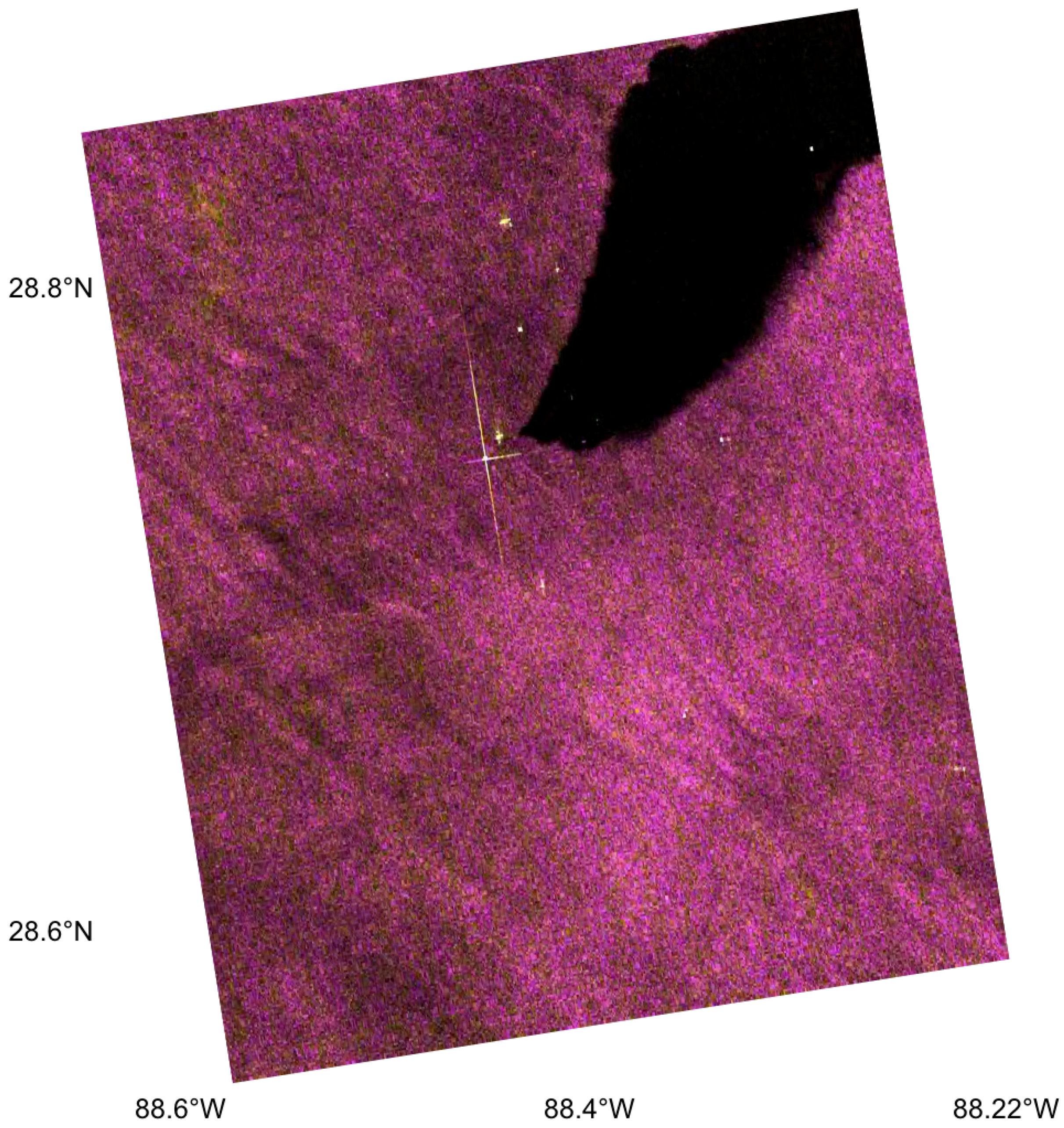
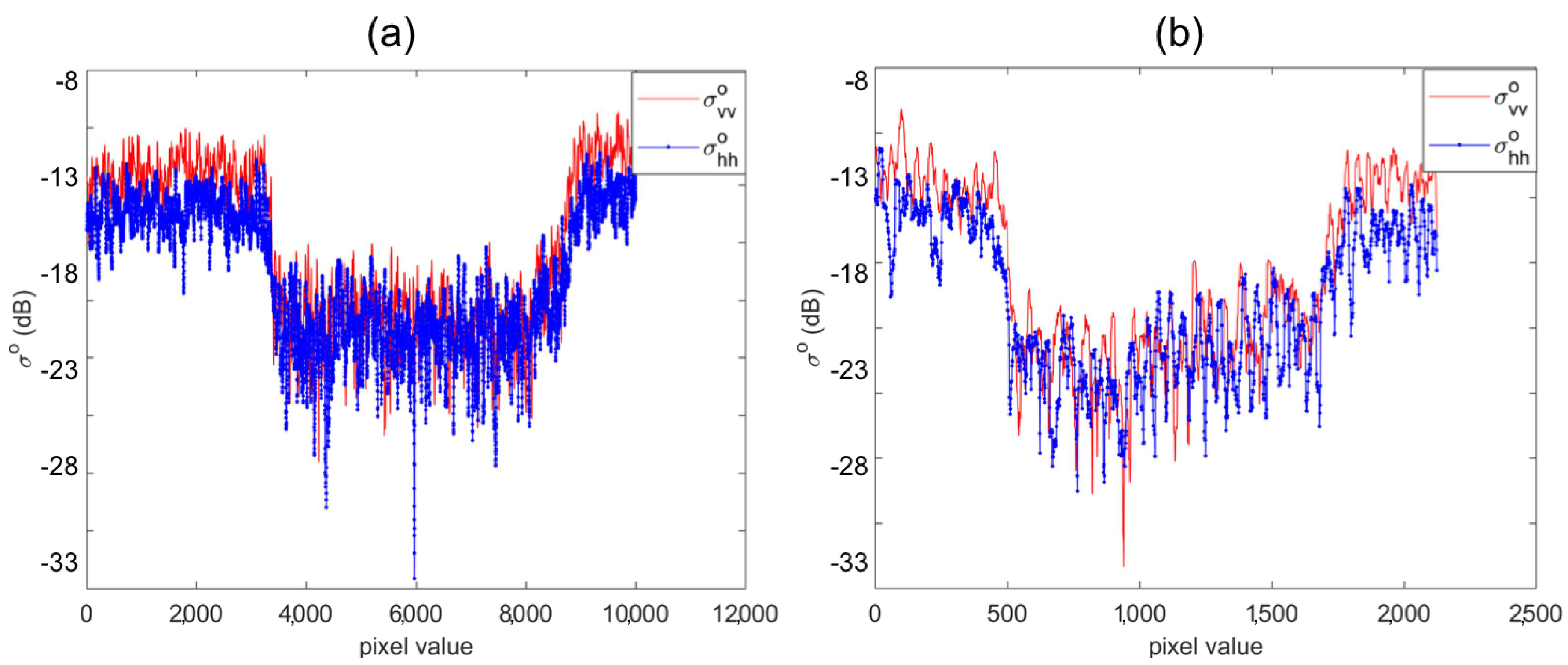
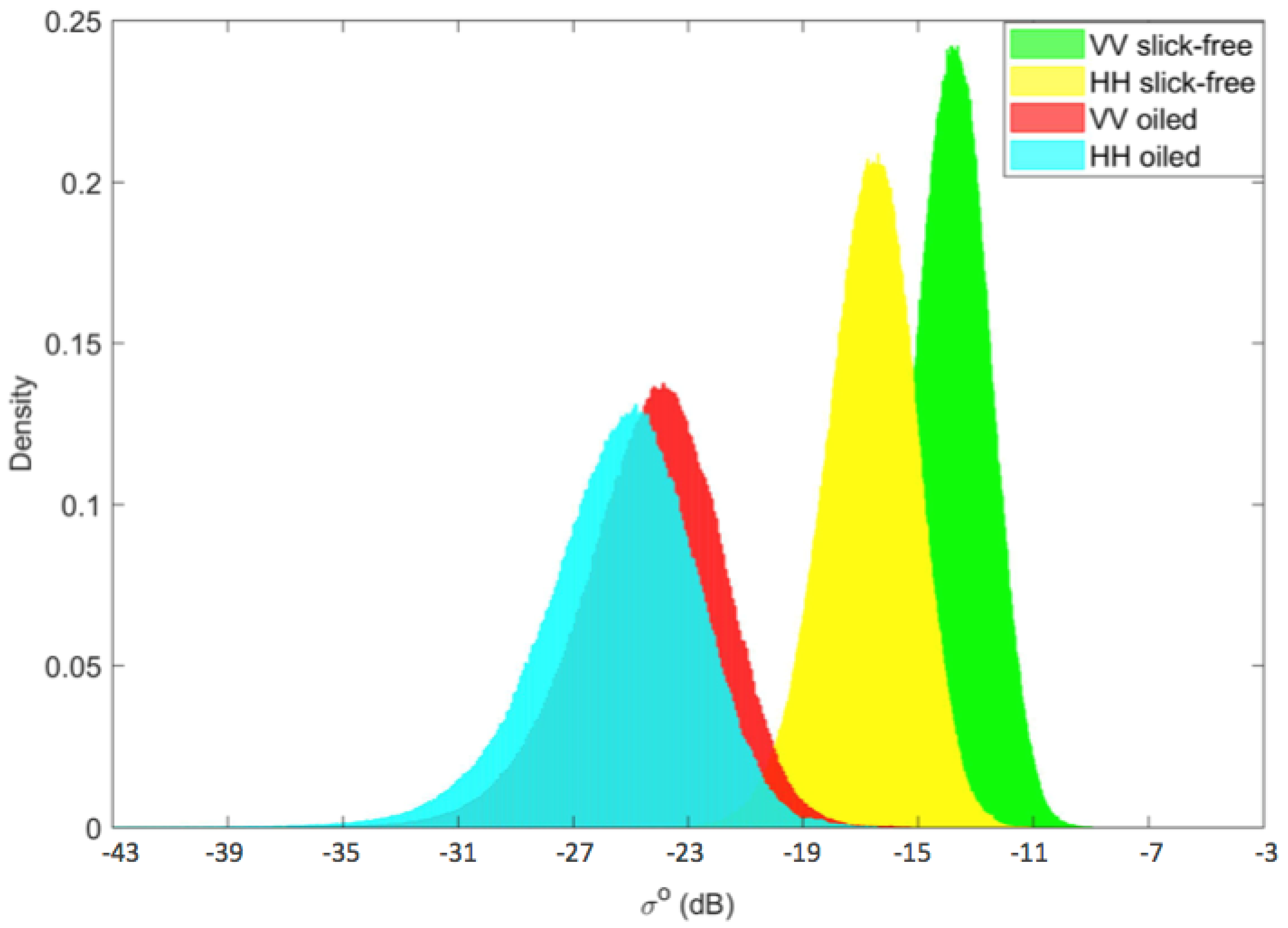
| Transect | ROI | (dB) | (dB) | (dB) | (dB) |
|---|---|---|---|---|---|
| Azimuth Direction | Sea | −13.18 | −15.94 | 11.15 | 8.95 |
| Oil | −24.33 | −24.89 | |||
| Range Direction | Sea | −12.68 | −15.16 | 10.12 | 8.05 |
| Oil | −22.80 | −23.21 |
| Parameter | HH | VV |
|---|---|---|
| Oil-sea | 0.8107 | 1.1250 |
| Overlapped area (%) | 51 | 38 |
© 2018 by the authors. Licensee MDPI, Basel, Switzerland. This article is an open access article distributed under the terms and conditions of the Creative Commons Attribution (CC BY) license (http://creativecommons.org/licenses/by/4.0/).
Share and Cite
Nunziata, F.; Buono, A.; Migliaccio, M. COSMO–SkyMed Synthetic Aperture Radar Data to Observe the Deepwater Horizon Oil Spill. Sustainability 2018, 10, 3599. https://doi.org/10.3390/su10103599
Nunziata F, Buono A, Migliaccio M. COSMO–SkyMed Synthetic Aperture Radar Data to Observe the Deepwater Horizon Oil Spill. Sustainability. 2018; 10(10):3599. https://doi.org/10.3390/su10103599
Chicago/Turabian StyleNunziata, Ferdinando, Andrea Buono, and Maurizio Migliaccio. 2018. "COSMO–SkyMed Synthetic Aperture Radar Data to Observe the Deepwater Horizon Oil Spill" Sustainability 10, no. 10: 3599. https://doi.org/10.3390/su10103599
APA StyleNunziata, F., Buono, A., & Migliaccio, M. (2018). COSMO–SkyMed Synthetic Aperture Radar Data to Observe the Deepwater Horizon Oil Spill. Sustainability, 10(10), 3599. https://doi.org/10.3390/su10103599







